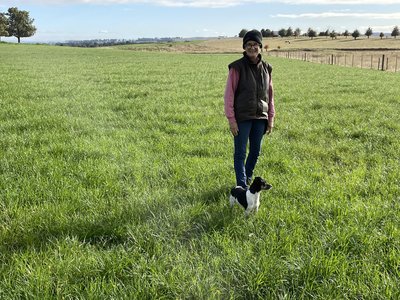Hogan annual ryegrass oversow for the win
It is one thing to believe you are doing a good job of fattening cattle, but to test yourself against your peers and shine, is vindication of time, effort and dedication.

Above: The fattening program of the Angus x Shorthorns provided Killandayle with a win at Lardner Park Steer Trial for weight gain and carcase grading
Marg and Tony Killalea, owners of Killandayle Beef near Holbrook, NSW have now been acknowledged twice in the Lardner Park Steer Trial competition with the highest weight gain and carcase grading over a five month period on Angus x Shorthorn cattle. The steer trial is based on average daily weight gain for a pair of steers plus analysis of the carcase using Meat & Livestock Australia’s MSA grading system.
A pasture based fattening operation, Killandayle Beef is 900 acres on deep loam, alluvial soils in a region historically regarded as notoriously acidic.
Over a period of more than 45 years, a program to establish and then renovate pastures has been underway. In early 2000’s, the application of lime to balance soil acidity was a game changer. Lime vastly improved the vigour and performance of the permanent pasture base (Phalaris, sub clovers and perennial ryegrasses) and enabled stocking numbers to rise.
While thorough regular soil testing is conducted very three years, the increases in the number of cattle that can be turned off, the average weight gain and stocking rates is proof enough that the soil has been substantially changed since improvements began.
The property currently runs around 400 steers and about 100 trade heifers as well as a cross-bred breeding program utilising AI and regular monitoring of cattle traits (EBVs such as mature cow weight, weight gains, milk) to maximise genetic expression and phenotype outcomes. Steer mob size is 60-80 head and based on approximately the same weight; additional mobs are based on incremental weight ranges of around 40kg to ensure that each animal is not competing against a much larger member of the herd for feed.
Steers stay in the cohort from an arrival weight of around 280 – 300kg liveweight and exit the farm approximately six months later at the 550-600kg mark.
Winter feed for weight gain
Holbrook can be cold and wet during winter and into spring, but with a pasture fed fattening system, options for winter feed need to be considered when much of the permanent pasture is dormant.
Marg and Tony have oversown a mix of Hogan annual ryegrass and forage oats for a number of years across a third of the property to give the cattle winter feed and bulk. A late maturing annual tetraploid variety, Hogan provides late season quality and re-growth, while the forage oats, also late maturing give additional bulk and is quick out of the ground. Tony’s sowing rate is 25kg/Ha apiece of the ryegrass and oats.
“What has drawn us to the Hogan ryegrass and oats mix is the absolute performance Hogan shows in our climate, environment and production system,” said Marg.
“It is well suited to our rainfall, our soil and doesn’t mind the cold. The bolster of winter feed over the permanent pasture is a superb feed gap option. It’s late maturity and longer growing range means that we can still see growth around December and January if we have late spring to early summer rains. We also get a decent bit of growth the following year, even though it is considered an annual.”
According to Territory Manager, Shayne Matthews, the region is prone to insect stress. The application of Poncho+ seed coating has given the property protection against African black beetle and Red Legged Earth Mites.
It is uncommon for the property to buy in supplemental feed, but if the opportunity to cut hay and silage is viable, they will do so on farm. Most recently, hay and silage has been drawn from three paddocks which are now being returned to permanent pasture for a spell and oversown with Bealey perennial ryegrass. Planted in a particularly wet year, the Bealey, according to Marg, had incredible germination, struggled a little with the wet, but is now hitting its straps during the Autumn. While the Bealey establishes its root system only light grazing will be undertaken.
Marg says that when Tony’s parents first bought the farm in the 1970s, the property was in poor condition and could only be lightly stocked. Today, the dung beetle activity and livestock performance are testament to the hard work and commitment the family has undertaken.
“Using Hogan has definitely been an investment but one that has paid back handsomely and enabled us to hit some of our business targets in terms of number of cattle units and weight gains – and weight gain is our business.
“We couldn’t be happier with the results of Hogan ryegrass.”

Above: Marg and her husband Tony Killalea of Killandayle Beef have been oversowing a mix of Hogan ryegrass and forage oats on permanent pasture to provide the winter feed needed for their pasture based fattening program.

